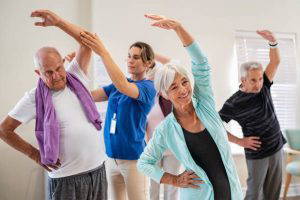Exercising When You Have Atrial Fibrillation
Healthline
Medically reviewed by Daniel Jennings, PA-C. Written by Rachel Nall, MSN, CRNA – Updated April 5, 2024
- Emergency symptoms
- Effects of AFib on exercise
- Talk to your doctor
- Recommended exercises
- Exercises to avoid
- Your heart rate
- Cardiac rehabilitation
- Takeaway
If you’ve been diagnosed with atrial fibrillation (AFib), many exercises should be safe to
continue (or start), but it’s important to work with a healthcare professional to identify
exercises that are safe for you and emergency symptoms to watch out for.
In many cases, exercising with atrial fibrillation (AFib) can help you live a stronger,
healthier life.
Exercise can help you maintain a healthy weight, which can have benefits for heart
health. There are also other cardiovascular benefits to physical activity, including
slowing your resting heart rate and lowering your blood pressure.
Exercise may also help relieve anxiety and stress, which may have positive effects on quality of life.
While you may be able to exercise with no complications from AFib, it’s important to
know which symptoms mean to slow down or stop altogether.
Read on to learn about symptoms to watch out for plus exercises to try and exercises
you may want to avoid.
Emergency symptoms when exercising with AFib
AFib can cause you to experience chest pain when exercising. If you experience chest
pain while exercising, you should stop exercising and rest. If your chest pain doesn’t
subside when you take a short break or rest, call 911 or your local emergency number.
You might also consider having someone drive you to the emergency room.
In addition to chest pain, other symptoms you should seek emergency treatment for
include:
- shortness of breath you can’t recover from
- shooting arm pain
- confusion or disorientation
- loss of consciousness
- sudden weakness on one side of your body
- slurred speech
- difficulty thinking clearly
Call your doctor if you have any other symptoms that cause you to feel uneasy or unwell.
AFib can make exercise difficult because your heart may start to race. A racing heart
can make your blood pressure drop and cause you to feel faint. In this case, strenuous
exercise can be more harmful than helpful. Always stop exercising and find a safe place
to sit down if you feel lightheaded.
Other symptoms you may experience.
One of the most common symptoms of AFib is tiring more easily when you exercise.
Other AFib symptoms that can make exercising more difficult include:
- heart palpitations
- dizziness
- sweating
- anxiety
- shortness of breath
Talk with your doctor.
Talk with your doctor about what you should and shouldn’t do when it comes to working out.
If AFib triggers any symptoms, your doctor may recommend you get the condition
under better control before you start exercising. Once your condition is managed and
it’s safe to begin exercising, your doctor should be able to work with you to develop an
exercise plan.
Considerations for people with a pacemaker
If you have a pacemaker, talk with your doctor about your exercise routine.
Your doctor may want to combine other treatments for AFib with a pacemaker, such as
medications or ablation (creating scar tissue to help control your heart rhythm).
These treatments may improve your ability to handle longer or more intense workouts.
Ask your doctor how these treatments will affect your heart before you develop an
exercise routine.
Considerations for people taking blood thinners.
Certain medications for AFib, such as warfarin (Coumadin), make you prone to bleed
more when you get injured. If you’re taking this or another blood thinner, ask your doctor
if it’s safe to take part in exercises that increase your risk of falls or physical injury.
Exercises for people living with AFib.
Before taking part in any kind of exercise, make sure to stretch your muscles or do some
low-impact exercise, like walking, for about 10 minutes to allow your heart to adjust to
the activity. Make sure you’re hydrated before you begin increasing your level of activity,
too.
Once you’ve warmed up, try exercises such as power walking, jogging, or hiking to get
a good workout without overloading your heart. Riding an exercise bike or using
an elliptical machine or treadmill may also be safe workouts for people with AFib.
Lifting light weights can also be a good workout. It can help you build muscle tone and
strength without overloading your muscles or straining your heart. If you’ve recently had
a surgical procedure, ask your doctor what you are allowed to lift. There are often strict
lifting restrictions for a certain amount of time following surgery. It’s important to follow
any guidelines to reduce your risk for post-operative complications.
Once your doctor has given you the OK to exercise, begin by trying short exercise
periods of 5-10 minutes to make sure the exercise won’t cause you to feel lightheaded
or faint. As you become comfortable with short periods of exercise, gradually add 5-10
minutes of exercise time until you feel that you’ve reached a satisfying personal fitness
goal.
Exercises to avoid with AFib.
If you haven’t exercised in a while, you don’t want to start with intense, high-impact
exercise. When you exercise with AFib, you may want to start with short intervals of
low-impact exercise. Then you can gradually increase the length and intensity of your
workouts.
Try to avoid activities with a higher risk of causing injury, such as skiing, rock climbing,
or outdoor biking. Many blood thinner medications used to treat AFib may make you
bleed more heavily when you’re injured.
If you plan to lift weights, talk to your doctor or a physical therapist about how much
weight is safe for you to lift. Lifting too much can put a lot of strain on your heart. It’s
also important to speak with your doctor about how much you are allowed to lift following
any procedure, and for how long any lifting restrictions are in place.
Check your heart rate.
You don’t have to engage in overly vigorous activity to enjoy the benefits of exercise.
With AFib, it might be a better idea to keep your exercise at a moderate level at first.
Keeping an eye on your heart rate can also help you maintain a safe pace during your
workouts.
Many fitness and exercise trackers are available to help you monitor your heart rate.
These fitness trackers are usually worn on your wrist like a watch (and usually look like
watches, too). Many of them also record detailed heart rate statistics that you can view
through an app on your smartphone, tablet, or home computer.
Among the most popular, well-known fitness tracker brands is Fitbit, which sells several
models of fitness trackers with built-in heart rate monitors. Companies such as
Apple, Whoop, and Samsung also sell fitness trackers.
According to the Centers for Disease Control and Prevention (CDC), moderately
intense physical activity should be 50 to 70 percent of your maximum heart rate.
To measure your heart rate while you work out, place your index and middle fingers on
the thumb side of your opposite wrist, just below your thumb, or on the side of your neck.
You can count your pulse for a full minute or count for 30 seconds and multiply by two.
Here are a few things to keep in mind when checking your heart rate:
Your maximum heart rate is determined by subtracting your age from 220.
For example, if you’re 50 years old, your maximum heart rate would be 170 beats
per minute (bpm).
- To exercise at a moderate level, your heart rate should be between 85 (from
multiplying 170 x 0.5) and 119 (from multiplying 170 x 0.7) bpm. - If you take beta-blockers, calcium channel blockers, or other medications used to slow
heart rate, you may notice your heart rate doesn’t seem to increase as much as you
would think, even when you’re exercising at a moderate pace. That’s a sign that these
medications are doing their job.
Consider cardiac rehabilitation.
It’s normal to feel nervous about exercise when you have AFib. But you don’t always
have to supervise your own heart rate during a solo workout. Talk to your doctor
about cardiac rehabilitation.
Cardiac rehabilitation just means exercising at a health facility where your heart can be
monitored. Options include a hospital, an outpatient center, or your doctor’s clinic. Staff
at the facility can caution you if your heart rate becomes too rapid or if you have an
abnormality in blood pressure.
The staff is also specially trained to help people with heart conditions such as AFib and
heart failure. They can provide tips on new exercises to consider and advice on exercise
safety.
You won’t need to go to cardiac rehab forever. Instead, it can be a great resource to
help you feel comfortable exercising on your own.
You may be asked to do an exercise stress test while you’re in cardiac rehabilitation. In
this test, you’ll walk on a treadmill that’s adjusted for speed and incline while you’re
connected to equipment that monitors your heart rate.
The exercise stress test allows your doctor to see how well your heart responds to
exercise, as well as how efficiently and consistently it pumps blood into your body. This
test can measure how much exercise your heart can manage before AFib symptoms
occur. Knowing what level of exercise is good for your heart can help you develop an
exercise routine that’s safe for your AFib.
The Takeaway
Ask your doctor to confirm whether you can take part in regular exercise sessions.
Ideally, these would be at a moderate exercise level.
Knowing the symptoms that could indicate you need to slow down or seek emergency
medical attention can help you stay healthy when exercising with AFib.
Sources:
Gutierrez OJ, et al. (2021). Cardiac implantable devices during exercise: Normal function and
troubleshooting. https://www.ncbi.nlm.nih.gov/pmc/articles/PMC8207372/
Keteyian SJ, et al. (2019). Exercise testing and exercise rehabilitation for patients with atrial
fibrillation. https://www.ncbi.nlm.nih.gov/pmc/articles/PMC6394874/
Pinckard K, et al. (2019). Effects of exercise to improve cardiovascular
health. https://www.frontiersin.org/articles/10.3389/fcvm.2019.00069/full
Target heart rate and estimated maximum heart rate.
(2022). https://www.cdc.gov/physicalactivity/basics/measuring/heartrate.htm
Last medically reviewed on April 5, 2024

